The cold weather in winter makes it not a peak season to travel to Beijing, with most attractions seeing much fewer crowds of tourists (except for the Spring Festival Holiday). But Beijing’s winter offers no fewer wonders than any other season.
The numerous ski resorts and ice rinks in the capital allow visitors to engage in many exciting winter sports and activities. When it snows, the snow-covered historic landmarks, like the Forbidden City, Summer Palace, and Temple of Heaven, will transform the city into a peaceful winter wonderland. The many winter festivals and cultural events in Beijing also add vibrancy and a joyous atmosphere to this season. What’s more appealing is that you can enjoy a Beijing tour at the lowest price in winter, making it a cost-effective yet unforgettable experience.
When is Winter in Beijing?
Winter in Beijing is long and cold each year. According to meteorological standards, Beijing’s winter typically lasts from early to mid-November to early March. From November, the average temperature in the city often falls below 10°C for five or more consecutive days, marking the official beginning of its winter. The chilliest days of the city often occur in January, when the average temperatures range from -6°C to 3°C (21°F – 37°F). Until early March, the average temperature in Beijing gradually rises above 10°C, signaling the end of winter.

Weather & Temperature in Winter in Beijing
Beijing’s winter is dominated by significantly low temperatures, with the average temperature often ranging between -5-5°C. The coldest days in Beijing can see temperatures dropping to -10°C (14°F) or even lower. The cold weather is often accompanied by strong winds, minimal precipitation, and exceptionally dry climate.
Large diurnal temperature variation still occurs in winter, with early mornings, evenings, and nights being notably colder than daytime. Thanks to the frequent sunny days in this season, it is generally ideal for many outdoor activities.
Despite the low temperatures, Beijing’s indoor heating ensures a warm and comfortable experience when visiting indoor venues like museums, shopping malls and popular restaurants.
What to Wear in Winter in Beijing
To stay warm and comfortable in Beijing’s winter, it is necessary to wear thick, insulated clothing such as padded jackets, down coats, leather jackets, or heavy wool coats. Scarves, hats, and gloves are also highly recommended to reduce skin exposure. Please dress in additional layers and thicker clothing if you have long-time outdoor activities or plan to visit suburban or mountainous areas, such as Mutianyu Great Wall and Badaling Great Wall.
Temperatures in Winter Months in Beijing
| Months | November | December | January | February | March |
| High Temperature(°C) | 11.6 | 4.6 | 3.2 | 7.2 | 14.7 |
| Low Temperature(°C) | -0.6 | -5.9 | -7.8 | -4.7 | 0.8 |
| Average rainy /snowy days | 4.4 | 1.5 | 1.8 | 2.9 | 3.5 |
| Average AQI | 105 | 72 | 77 | 79 | 130 |
Top Things to Do and See in Beijing in Winter
Discover the Unique Charm of the Forbidden City in Winter
As a top attraction in Beijing in any season, the Forbidden City is known for its grand halls and intricate imperial architecture. In winter, with fewer visitors, you can explore its highlights at your own pace and imagine the lives of emperors and courtiers during the Ming and Qing Dynasties.
The view after a snowfall is especially stunning. You’ll witness how the snow-covered red walls and yellow titles transform the palace into a majestic wonderland.
Jingshan Park is the best spot to enjoy the snow-covered scenery of the Forbidden City. As the highest point in central Beijing, Wanchun Pavilion at the summit of Jingshan Hill offers visitors breathtaking panoramic views of the Forbidden City and Beijing Central Axis.
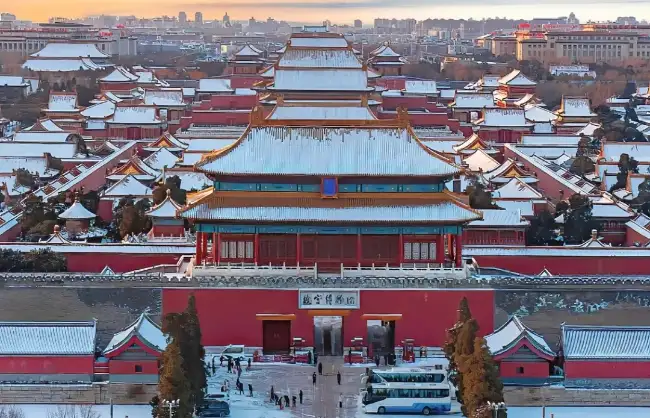
Hike the Great Wall for Winter Sightseeing
In winter, the absence of crowds at the Great Wall allow you to hike the ancient pathways undisturbed and immersively appreciate the magnificent structure of the walls. The clear skies and high visibility offer more stunning panoramic views of the surrounding mountains. After a snowfall, the view is particularly unparalleled when the snow-covered walls show like a silver dragon winding its way through the mountains.
Ice Skating at Shichahai
Located in the heart of old Beijing, Shichahai is a rare place that retains both the city’s natural beauty and historical charm. Here, you can leisurely stroll around the lake or explore the hutongs to discover traditional courtyard life. During the freezing months of the year, the frozen Shichahai Lake transforms into a winter playground for locals and tourists of all ages. No one can deny the thrill of ice skating on the frozen lake. Many exciting activities are available for you to discover the joy of winter, from ice skating and ice chair rides to exhilarating dog sledding and speed skating races.
Good to know: The ice rink is open from 9:00 AM – 6:00 PM. And the exact opening dates depend on the lake’s freezing conditions.
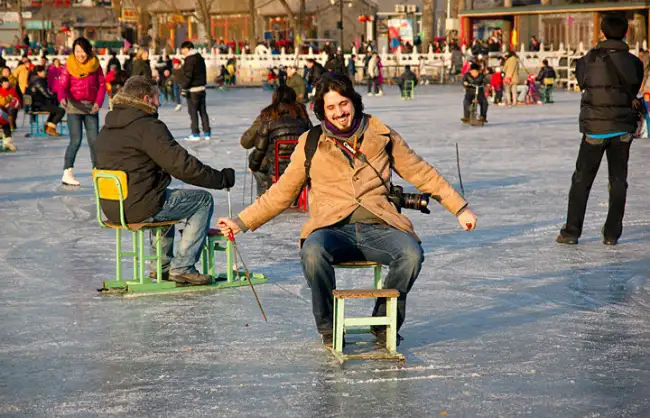
Skiing in Beijing
Skiing in Beijing is one of the most popular winter activities now. Since the 2022 Winter Olympics, there have been dozens of ski resorts opened in suburban Beijing. No matter your ski level, the many ski resorts here offer a variety of slopes to suit visitors of all levels, even if you are a beginner. See below for the top ski resorts near Beijing:
Badaling Ski Resort
Badaling Ski Resort is about only a 1-hour and 10-minute drive from downtown Beijing. Since near the famous Badaling Great Wall (about 3 kilometers west), this ski resort is a perfect combination for Great Wall exploration and exciting winter sports. There are 6 ski slopes to cater to different levels from beginner to advanced. Besides the slopes, it also offers a wide range of family’s preferred activities, including dog sledding, snow sculptures, and a children’s playground. The professional ski training center here can help beginners to get started easily.
Jundu Mountain Ski Resort
About an hour’s drive from downtown Beijing, Jundu Mountain Ski Resort in the Changping District features its diverse range of slopes and excellent snow quality. Its 11 ski slopes can cater to beginner, intermediate, and advanced skiers. Built on the unique topography, the advanced slopes here are particularly challenging, with large vertical drops offering an adrenaline-rush experience. Families with kids can enjoy a fun time at its children’s snow park. Additionally, the unique military-themed games allow visitors to engage in simulated combat with tanks, armored vehicles, and jeeps.
Huaibei International Ski Resort
Located in the Huairou District, Huaibei Ski Resort is about 1.5 hours’ drive from downtown Beijing. It offers 10 slopes for beginner, intermediate, and advanced runs, and the 800-meter intermediate slope is especially popular. The wide and moderate slopes here make it more accessible for beginners and intermediate skiers.
Nanshan Ski Resort
About 1 hour’s drive from downtown Beijing, Nanshan Ski Resort boasts 21 trails that cater to different skill levels, and one of the largest ski parks in Asia. The ski park is equipped with half-pipes, moguls, and other specialized facilities, making it especially popular among young skiers who enjoy freestyle and trick skiing.

Photograph the Winter Charm of the Summer Palace
With each season offering different scenic beauty, the Summer Palace in winter shows not only the stunning snowscape but also the tranquil beauty of the frozen Kunming Lake. When the setting sun casts its golden glow over the icy surface of the lake, the ice and the warmth of the sunset create a picturesque contrast of light and shadow. If you visit the park around the Winter Solstice, you may luckily capture the spectacle of slanted sunlight passing through the arches of the famous Seventeen-Arch Bridge.
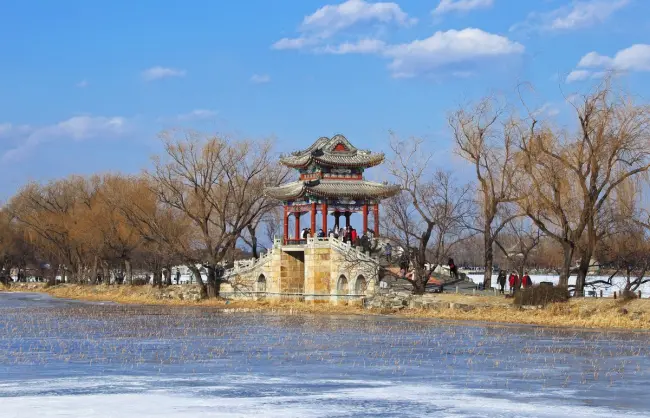
Experience Beijing’s Winter Cuisine
Don’t miss the unique culinary experience if you travel to Beijing in winter. The city offers diverse classic dishes and street foods that are rich in tradition, warmth, and cultural heritage.
The many traditional favorites in Beijing, such as copper pot lamb hotpot, lamb stew, zhajiangmian (fried sauce noodles), and “yang xie zi” (spicy lamb spine hot pot), are not only beloved for their rich flavor and deep historical roots but also for their warmth and energy-boosting properties.
Popular street snacks and desserts, like roasted sweet potatoes, sugar-fried chestnuts, court-style milk cheese, and tanghulu (candied hawthorns), add a delightful flavor to Beijing’s streets and offer an insight into the daily eating habits of ancient Beijing residents.
- Recommended places to savor authentic Beijing flavors: Nanluoguxiang, Niujie, and Guijie
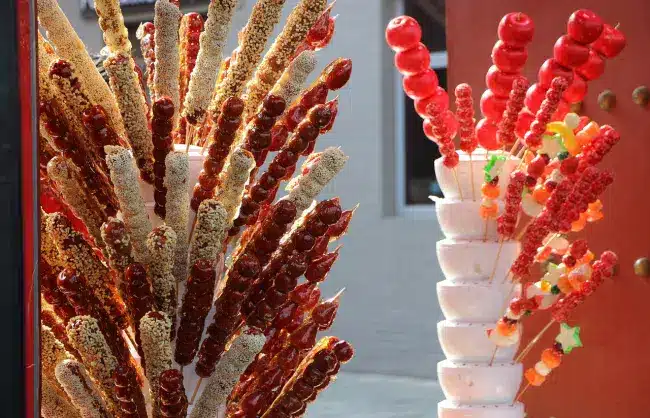
Popular China Winter Tours including Beijing:
- 8 Days China Winter Tour of Beijing, Harbin, Shanghai
- 11 Days China Winter Tour of Beijing, Xian, Harbin, Shanghai
- 6 Days Harbin Ice Snow Tour from Beijing by Bullet Train
Cultural and Festive Highlights in Winter in Beijing
Chinese New Year
The Chinese New Year is the most important traditional festival in China, featuring diverse customs and celebrations. Beijing, as the capital city, offers a wealth of cultural activities to showcase both traditional and modern aspects of Chinese culture. From temple fairs to Peking opera performances, from folk customs to contemporary celebrations, the city is no shortage of cultural heritage to offer visitors during this period.
The Heaven Worship performance will be held at the Temple of Heaven every Spring Festival from the first day to the fifth day. In the Forbidden City, you can watch many intangible cultural heritage performances, traditional crafts and special royal exhibitions. At the Great Wall, visitors can not only enjoy an immersive hiking experience but also encounter the traditional dragon and lion dances and folk art displays. The bustling hutongs are more alive in festive atmosphere, with red decorations, snacks, and handcrafted goods scattered in every corner.
Join in One of Temple Fairs in Beijing
- Popular Temple Fairs near Beijing: Longfu Temple Fair, Changdian Temple Fair, Baiyun Temple Fair, Longtan Lake Temple Fair, Ditan Temple Fair
Temple fairs are an ancient folk tradition in Beijing. As its name suggests, a temple fair is a gathering held at temples, Taoist temples, and surrounding areas. The first day of the new year to the second day of the dragon’s head rise (February 2) are the peak period when most temple fairs are held in Beijing.
These fairs usually offer a diverse mix of performances, religious ceremonies, folk entertainment, traditional music, games, and commercial activities. To visit one of these fairs, you can join the locals to enjoy the festive atmosphere and buy some folk crafts as souvenirs.
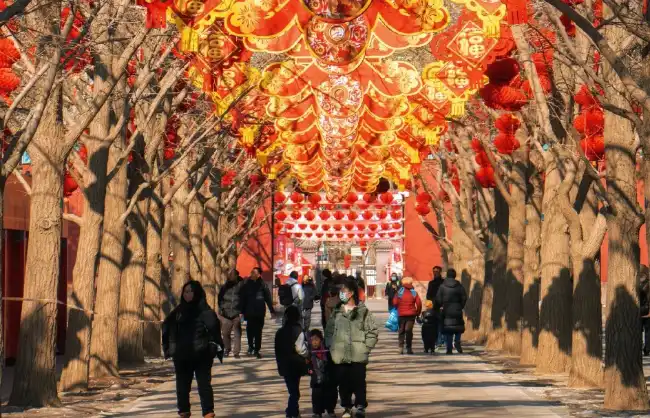
Longqing Gorge Ice and Snow Festival
Longqing Gorge Ice and Snow Festival is held annually in the Longqing Gorge Scenic Area in Yanqing District from mid-January to the end of February. As a highly anticipated event, it has been celebrated 38 times by 2024. During the festival, visitors can admire over 200 ice sculptures and 100 snow sculptures on display, with both exquisite pieces and massive installations available. To add excitement to the festival, there are also spectacular light shows, various ice-based activities, intangible cultural heritage displays, and music and dance shows arranged during the festival.










